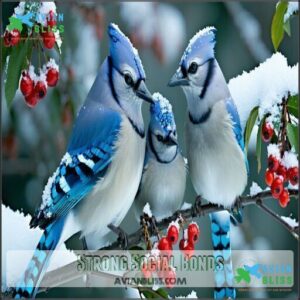This site is supported by our readers. We may earn a commission, at no cost to you, if you purchase through links.
 Yes, blue jays are corvids! They’re part of the Corvidae family, which includes other brainy birds like crows, ravens, and magpies.
Yes, blue jays are corvids! They’re part of the Corvidae family, which includes other brainy birds like crows, ravens, and magpies.
Known for their vibrant blue feathers and bold personalities, blue jays share classic corvid traits—sharp intelligence, strong social bonds, and problem-solving skills.
They even mimic hawk calls to confuse predators or other birds, showing off their clever side. Taxonomically, they belong to the genus Cyanocitta, making them close relatives of Steller’s jays.
So, next time you spot a blue jay, remember you’re watching one of nature’s smartest birds in action. Curious about their mimicry tricks? Keep reading for more!
Table Of Contents
- Key Takeaways
- Are Blue Jays Corvids?
- Are Blue Jays Considered Corvids?
- Common Characteristics of Corvids
- Corvid Intelligence and Problem-Solving Skills
- Corvid Species in North America
- Unique Behaviors of Canada Jays and Clark’s Nutcrackers
- Role of California Scrub-Jays and Pinyon Jays in Ecosystems
- Distinct Behaviors of Woodhouse’s Scrub-Jays and Fish Crows
- Blue Jays’ Social Systems and Family Bonds
- The Feeding Habits and Foraging Behavior of Blue Jays
- Frequently Asked Questions (FAQs)
- Conclusion
Key Takeaways
- Blue jays are part of the corvid family, sharing intelligence, social bonds, and problem-solving skills with crows, ravens, and magpies.
- They mimic hawk calls to confuse predators or outsmart competitors, showcasing their clever survival tactics.
- Blue jays cache food like acorns for later use, relying on sharp memory to retrieve them months later.
- Their vibrant blue feathers aren’t actually blue but appear so due to light scattering, a natural optical illusion.
Are Blue Jays Corvids?

Wondering if blue jays are corvids? They absolutely are! These striking birds belong to the corvid family, sharing traits like stout bills, glossy feathers, and sharp intelligence with their relatives—crows, ravens, and magpies.
Blue jay origins trace back through an evolutionary history confirmed by genetic studies, solidifying their place in avian classification.
Known for clever survival tactics, they mimic predator calls and cache food for later. Blue jays embody corvid traits, proving that this bird species is as smart as it’s stunning.
Are Blue Jays Considered Corvids?
You might be surprised to learn that blue jays are indeed part of the corvid family, which includes crows, ravens, and magpies.
Their strong bills, striking plumage, and clever behaviors firmly place them within this intelligent bird group.
Corvid Family Characteristics
The corvid family boasts a mix of traits that make its members, like blue jays, truly fascinating. From their physical traits to their clever behaviors, corvid family characteristics are hard to miss.
These birds sport stout bills perfect for cracking nuts, glossy feathers that gleam in sunlight, and scaly legs that give them a rugged charm. Corvids are also vocal pros. Their vocalizations range from mimicry of predators to complex calls for social bonding.
They thrive in diverse habitats, from forests to city parks, showcasing their adaptability. Here’s a quick snapshot of corvid behaviors and traits:
- Minimal sexual dimorphism, with males slightly larger than females.
- Strong social bonds, often forming lifelong pairs.
- A wide habitat range, including urban areas and wilderness.
It’s no wonder corvid species are admired for their versatility and intelligence.
Blue Jay Intelligence
Blue jays are brilliant birds, showcasing corvid intelligence in impressive ways.
Blue jays amaze with their sharp memory and mimicry, proving intelligence isn’t just for the biggest brains in nature.
Their problem-solving skills are nothing short of remarkable—imagine a bird crafting tools from newspaper strips to outwit predators. Known for their sharp cognitive abilities, they can recall thousands of food cache locations for months, a feat of memory that would leave even the most organized among us envious.
Social learning is another hallmark of their avian intelligence. Young blue jays watch and learn from adults before attempting complex foraging tasks themselves.
And let’s not forget their mimicry skills—they’ve been known to imitate hawk calls, either to warn others or cleverly distract predators. These behaviors highlight their adaptive intellect and solidify their place among nature’s smartest problem-solvers.
Taxonomic Classification Debate
In the context of bird classification, there’s no argument—blue jays are firmly part of the corvid family.
Scientists have placed them in the Corvidae family alongside crows, ravens, and magpies, and modern genetic evidence seals the deal. Their evolutionary history and phylogenetic analysis highlight their deep connection to this intelligent bird group.
You can see their corvid roots in their behavior and appearance, despite their striking blue feathers and crested heads. These features might make them stand out, but their shared ancestry is undeniable.
Here’s why their classification sticks:
- Phylogenetic analysis confirms their evolutionary fit within Corvidae.
- Their morphological traits, like stout bills, match other corvids.
- Genetic evidence rules out hybridization with non-corvid species.
- Their bird taxonomy has been stable for centuries.
Blue jays are corvids through and through!
Common Characteristics of Corvids
You’ll recognize corvids by their stout bills, strong bodies, and glossy feathers, which help them thrive in various environments.
These birds also share scaly legs and bristled nostrils, making them well-suited for foraging and other survival tasks.
Stout Bills and Strong Body Build
A blue jay’s stout bill is its ultimate survival tool, showcasing remarkable bill morphology that’s perfect for cracking nuts, snatching insects, or prying bark.
These features highlight the jay characteristics that make them adaptable foragers. Combined with their sturdy body build and physical strength, blue jays thrive in diverse habitats. Their compact size allows nimble movement through trees, while their strong muscles help carry hefty food items with ease.
- **Did you know?
** Blue jays’ foraging adaptations let them handle a wide diet, from seeds to small critters, showing incredible diet versatility.
As part of the corvid family, this bird species excels at turning challenges into opportunities. To support these feeding habits, consider investing in durable feeding solutions.
Glossy Feathers and Scaly Legs
When you spot a blue jay, its glossy feathers might catch your eye, shimmering like nature’s own hologram.
This Feather Iridescence isn’t just for show—it’s a clever trick of light reflection. The scaly legs? They’re not just rugged; their Scale Morphology offers excellent Leg Protection and a firm grip for perching.
Plus, their feathers are built for durability, making Feather Maintenance a breeze. These traits highlight Corvid Adaptation, blending beauty and practicality.
The corvid family, including blue jays, showcases these features, proving that even among bird species, style and function go hand-in-hand. Their plumage also provides effective camouflage patterns, essential for survival.
Strong Social Bonds
In the context of social smarts, the corvid family, including blue jays, truly shines.
These birds form tight-knit family bonds and thrive on teamwork, showcasing remarkable intelligence and adaptability.
- Pair bonding: Blue jays often mate for life, sharing the workload of nesting and raising chicks.
- Family dynamics: They practice cooperative breeding, where relatives help care for young.
- Communication signals: Warning calls alert the group to predators, keeping everyone safe.
- Social hierarchy: Structured roles within flocks maintain order and reduce conflict.
- Playful bonding: Sharing food and playful antics strengthen relationships within the group.
Their social systems prove that teamwork makes the dream work!
Corvid Intelligence and Problem-Solving Skills
In the context of bird intelligence, corvids are in a league of their own. Their cognitive abilities rival those of some mammals, showcasing remarkable problemsolving skills and adaptability. Imagine a crow dropping walnuts onto busy roads so cars can crack them—now that’s innovation.
Corvids are also masters of tool use, crafting sticks or even bending wires to reach food. Their memory capacity is astounding, as they can recall hundreds of hidden food caches for months. Plus, they excel in social learning, observing others to pick up new tricks.
Some corvids can even demonstrate self-awareness in mirrors.
- Recognize individual faces, including humans.
- Mimic predator calls to outwit threats.
- Form alliances to protect resources.
- Adapt strategies based on past experiences.
Corvid intelligence truly redefines “birdbrain”!
Corvid Species in North America
North America is home to a fascinating variety of corvid species, including crows, ravens, magpies, and jays. Each species has unique traits, but they all share remarkable intelligence and adaptability.
American Crows and Their Adaptability
American crows, stars of the corvid family, are masters of survival.
Whether in bustling cities or quiet farmland, their adaptability shines. Thanks to their diet adaptations, these clever birds snack on everything from roadkill to French fries.
Urban crow survival isn’t just about food—they use corvid intelligence and problem solving to navigate threats and find resources.
Their social smarts are equally impressive, with crow communication helping them defend territories and outwit predators. This bird behavior makes American crows a fascinating example of how corvids thrive across diverse habitats, showcasing their ability to thrive across diverse habitats.
Common Ravens and Tool Usage
Common ravens are like the engineers of the corvid family, turning ordinary objects into tools with remarkable ingenuity.
Their ability to problem-solve rivals many mammals, and their cleverness never fails to impress.
Here’s how common ravens showcase their tool-using skills:
- Crafting tools: They shape twigs into hooks to extract grubs from tight spaces.
- Water manipulation: Dropping pebbles into containers raises water levels, bringing floating food within reach.
- Food stabilization: Using wedge-shaped objects, they secure food while tearing it apart.
- Strategic stacking: Arranging items helps them access out-of-reach treats.
What’s fascinating is their ability to learn from experience. Ravens remember successful techniques for months, proving their advanced cognition. Raven tool use isn’t just survival—it’s innovation, making them standout members of the corvid family.
Blue Jays’ Mimicry Abilities
Unlike ravens with their tool tricks, blue jays flaunt their smarts through vocal mimicry. These clever members of the corvid family can imitate hawk calls so convincingly that even seasoned birdwatchers might second-guess themselves.
But it’s not just a party trick—this predator deception helps them scare off smaller birds, snagging prime access to food. Scientists think this mimicry evolution stems from survival instincts.
Beyond hawk impressions, blue jays have a wide repertoire of bird calls, showing off their learning mechanisms and knack for interspecies communication. It’s like nature gave them a voice recorder and a mischievous streak!
Black-Billed Magpies’ Social Behaviors
Black-billed Magpies are the social butterflies of the corvid family, showcasing behaviors that highlight their intelligence and tight-knit communities.
Their lives revolve around a fascinating social hierarchy, where cooperation and communication shine.
Here are three key aspects of their social system:
- Cooperative Breeding: Older siblings pitch in to raise younger ones, creating a family dynamic that’s all about teamwork.
- Territory Defense: Magpies fiercely guard their year-round territories while maintaining surprisingly diplomatic relations with neighbors.
- Magpie Communication: With over 40 calls and postures, these birds coordinate everything from foraging to mob behavior against predators.
Their dome-shaped nests are engineering marvels, often taking weeks to construct.
Beyond practicality, magpies strengthen social bonds through food sharing and mutual grooming.
These behaviors underscore the corvid social systems that make Black-billed Magpies true masters of community living.
Steller’s Jays’ Nest Predation
While magpies excel at social networking, Steller’s Jays, another standout in the corvid family, specialize in nest predation. These clever blue-crested birds scour forests, targeting unguarded eggs and nestlings with precision.
Their actions force smaller bird species to sharpen their predator identification skills, often developing unique alarm calls specifically for Steller’s Jays.
This behavior impacts breeding success in forest habitats, as songbirds adapt by choosing safer nesting sites or employing nest defense strategies.
Despite the habitat impact, Steller’s Jays play a natural role in maintaining ecological balance. Their corvid intelligence shines through in their resourcefulness, reminding us how fascinating and complex these bird species truly are—even as they raid nests.
Unique Behaviors of Canada Jays and Clark’s Nutcrackers
High in the mountains, Canada Jays and Clark’s Nutcrackers showcase survival mastery through their unique food caching and corvid intelligence.
These birds thrive in harsh alpine habitats with remarkable adaptations:
- Canada Jay caching uses antimicrobial saliva to preserve food for months.
- Nutcracker seed dispersal aids forest regeneration, moving 90 seeds in one trip.
- Cooperative breeding guarantees survival in tough conditions.
- Altitudinal migration helps them adapt to seasonal changes.
Their foraging success relies on specialized beak adaptations for efficient feeding.
Their specialized behaviors and social learning make them true alpine survivalists.
Role of California Scrub-Jays and Pinyon Jays in Ecosystems
The California Scrub-Jay and Pinyon Jay are like nature’s gardeners, shaping ecosystems with their incredible seed dispersal skills.
These corvid family members scatter thousands of seeds, ensuring future forests thrive. California ScrubJay caching boosts oak and pine regeneration, while Pinyon Jays, essential for pinyon pine health, distribute up to 20,000 seeds yearly.
Their ecosystem interdependence supports biodiversity impact and habitat conservation.
Here’s how they help:
| Species | Seeds Dispersed | Key Habitat | Impact |
|---|---|---|---|
| California Scrub-Jay | Thousands | Oak woodlands | Forest regeneration |
| Pinyon Jay | 20,000 annually | Pinyon-juniper forests | Biodiversity and habitat health |
| Both | Caches unretrieved | Mixed woodlands | Ecosystem engineers |
| Pinyon Jay | Keystone species | Arid regions | Important for ecosystem stability |
These birds truly plant the seeds of tomorrow!
Distinct Behaviors of Woodhouse’s Scrub-Jays and Fish Crows
Woodhouse’s Scrub-Jays and Fish Crows, both members of the corvid family, showcase fascinating avian behavior through unique traits.
Here’s how they stand out:
- Scrub-Jay Caching: Woodhouse’s Scrub-Jays excel at storing thousands of seeds across their territories, relying on sharp memory to retrieve them.
- Vocal Mimicry: Fish Crows use an impressive 23 distinct calls to navigate their social hierarchy and communicate needs.
- Habitat Adaptation: While Scrub-Jays thrive in dry woodlands, Fish Crows prefer wetlands and coastal areas.
Both species demonstrate corvid intelligence, from problem-solving to sentinel behavior.
Their diets, like pine nuts for Scrub-Jays, reflect their ecological niches perfectly.
Blue Jays’ Social Systems and Family Bonds
Blue jays are social masterminds, showcasing family dynamics that highlight their place in the corvid family.
These birds form lifelong pair bonds, sticking with their mates through thick and thin—a true "’til death do us part" scenario.
Their social hierarchy is intricate, relying on calls and body language for smooth family communication.
For instance, a lowered crest signals trust when feeding together or caring for nestlings.
What’s fascinating is their knack for cooperative breeding.
Older siblings often pitch in to help raise the next generation, creating a tight-knit bird family.
Juvenile development is equally impressive—young blue jays spend weeks observing adults before mastering complex social interactions.
They also exhibit mobbing behavior to defend against predators.
They even practice anting, a quirky behavior where they use ants to keep feathers parasite-free.
- Fun fact: Blue jays’ family teamwork rivals human households during Thanksgiving prep!
The Feeding Habits and Foraging Behavior of Blue Jays
Blue jays are masters of resourcefulness, showcasing clever foraging strategies that highlight their corvid intelligence.
Blue jays cleverly cache acorns and mimic hawk calls, proving their intelligence and adaptability in every season.
They’re famous for caching acorns, often hiding hundreds in the ground and remembering these spots for up to nine months—a skill many humans might envy during grocery runs! Their diet adaptations are equally impressive, ranging from fruits and nuts to insects and even small frogs.
At feeders, you’ll notice their food preferences lean toward peanuts, sunflower seeds, and suet. With throat pouches capable of holding multiple acorns, they stash food for later use. Blue jays even mimic hawk calls to scare off competitors, proving their problem-solving prowess.
Many enthusiasts provide specialized bird feeders to cater to their preferences.
| Behavior | Purpose | Example | Season |
|---|---|---|---|
| Caching Acorns | Winter food storage | Hiding acorns | Fall/Winter |
| Mimicking Hawk Calls | Clearing competitors | Feeder takeover | Year-round |
| Selective Foraging | Optimizing food choices | Picking peanuts | Year-round |
| Seasonal Diet Shift | Adapting to scarcity | Eating more seeds | Winter |
Frequently Asked Questions (FAQs)
What class is a blue jay?
A blue jay belongs to the class Aves, which includes all birds.
It’s part of the Corvidae family, known for intelligence and bold personalities.
Think of them as the brainy, feathery cousins of crows and ravens!
What is a blue jay bird?
Imagine spotting a bird with bright blue feathers, a jaunty crest, and a loud “jayyy” call.
That’s a blue jay—an intelligent, social bird found in forests, backyards, and feeders across eastern North America.
Is a blue jay a crow?
No, a blue jay isn’t a crow, but they’re close relatives.
Both belong to the corvid family, sharing traits like intelligence and adaptability.
Think of them as cousins—different looks, same sharp minds!
How long do blue jays live?
In the wild, blue jays typically live around 7 years, though some have reached
In captivity, they can live longer.
Their survival depends on avoiding predators, harsh winters, and securing enough food.
How do you classify a blue jay?
Think of a family reunion where everyone shares striking traits—strong builds, sharp wits, and bold personalities.
You’d classify a blue jay as a proud corvid, blending intelligence, vibrant feathers, and unmistakable calls into nature’s lineup.
Are Blue Jays Blue?
They’re not actually blue!
Blue jays’ feathers contain brown pigment, but light scattering creates the vibrant blue you see.
It’s like a natural optical illusion—nature’s way of showing off without using actual blue dye.
What Do All Corvids Have in Common?
Corvids are like nature’s multitaskers—they all share stout bills, strong bodies, scaly legs, and bristled nostrils.
Their glossy feathers, loud calls, and sharp intelligence make them stand out as some of the smartest birds around.
Are Blue Jays in the Corvid Family?
Yes, blue jays are part of the corvid family, which includes crows, ravens, and magpies.
They share traits like intelligence, strong bills, and glossy feathers, making them clever, colorful members of this bird group.
Are Blue Jays and Cardinals in the Same Family?
Blue Jays and Cardinals aren’t in the same family.
Blue Jays belong to the Corvidae family with crows and ravens, while Cardinals are part of the Cardinalidae family, known for their vibrant red feathers and melodic songs.
Is a Blue Jay a passerine?
Birds of a feather flock together, and Blue Jays fit right in as passerines.
These perching birds share traits like three forward-facing toes and one backward, making them excellent at gripping branches and hopping around.
Conclusion
It’s ironic how such a flashy bird could belong to the often-overlooked corvid family, but yes, blue jays are corvids.
Their intelligence, mimicry skills, and social nature make them stand out even among their clever relatives.
Next time you see one, remember you’re watching a bird capable of confusing predators, solving problems, and forming strong family bonds.
Understanding these traits helps you appreciate their role in ecosystems and why they’re considered one of nature’s smartest birds.
- https://www.nhm.ac.uk/our-science/our-work/biodiversity/passerine-bird-evolution.html
- https://www.bbc.com/future/article/20191211-crows-could-be-the-smartest-animal-other-than-primates
- https://myfwc.com/wildlifehabitats/profiles/birds/songbirds/florida-scrub-jay/
- https://www.youtube.com/watch?v=8gmVOMEhMj8
- https://www.ncbi.nlm.nih.gov/pubmed/17806587













